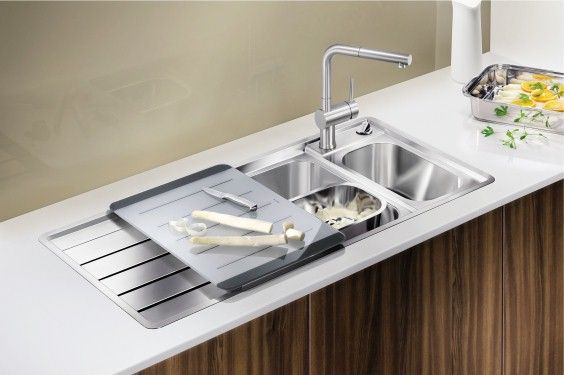How to Choose the Perfect Sink
The perfect sink for any kitchen is all about appearance and practicality. It should reflect the style of the room – a sink can often be the centrepiece of a kitchen – and help to make preparing food the way you like, and all your other kitchen tasks, as convenient and hassle-free as possible. If you make the right choice, then there’s no need to compromise on either looks or functionality. So it’s time to figure out what you want from your sink – the style and features that will provide what your kitchen needs. There are so many fantastic sinks available today, so be sure to choose the one that’s right for you.
Build Materials
The construction of your sink isn’t just a factor in how it looks. The build materials also affect how easy it is to clean and maintain. There are a lot of options, so here are some of the things you should consider:
Stainless Steel Sinks

A very low-maintenance option (no rust or corrosion), and easy to wipe down after use so they shouldn’t stain over time. Stainless steel sinks remain the most popular choice among UK homeowners, which isn’t surprising given the vast range of styles on offer. They are light, flexible in terms of installation options, and can be very inexpensive. Potential drawbacks are that they can be noisy, and are prone to dents and scratches if you’re not careful.
Granite Composite Sinks

Extremely hardwearing and durable, they’re difficult to chip or scratch and virtually heat- and stain-resistant. You can place a hot pan from the oven on a granite composite sink and everything will be fine. However, they do require more maintenance than, say, stainless steel to keep them looking their best. And they’re heavier too, so you’ll need a stronger worktop base. A plain white granite composite sink works in either traditional or contemporary settings. And there’s a mind-boggling range of other colours and finishes to choose from as well.
Ceramic Sinks

Classically stylish, a ceramic sink fits into almost any kitchen, smooth as a hand into a silk glove. They’re easy to wipe clean, even if you don’t do it right away. (You should though!) And they’re durable enough to last a lifetime – although be aware that ceramic sinks can chip; they are usually repairable but it’s still something to avoid. Ceramic sinks are the ideal centrepiece if you want to create a classic kitchen workspace. They can be expensive though, more costly than either stainless steel or composites. And they are heavier than a composite sink too.
Sink Mountings
The way your sink is installed has a big effect of its appearance. So it’s worth considering the look you want to achieve.
Inset Sinks

An inset sink rests on your kitchen work surface, with a pre-cut hole in the worktop providing space for the sink bowl as well as plumbing access for water and waste. Insets are the most popular type of sink installation, so you’ll find an enormous range of designs and styles. If you have a contemporary kitchen interior, then you’ll find sleek, eye-catching inset sinks that will complement it perfectly. Or if your kitchen is more rustic or traditional in style, then there are lovely ceramic sinks that will fit right in. Because they’re installed on top of the work surface, inset sinks are often supplied with a useful draining area attached. This is less common with other types of sink.
Undermount Sinks

Fitted beneath a cut-out in the countertop, an undermount sink leaves the surrounding work surface smooth and unsullied. This makes it a particularly excellent choice if your kitchen work surfaces are an attractive solid material that you’d like to show off, such as granite, marble or hardwood. The edges of a properly installed undermount sink are hidden beneath the surrounding worktop, creating the most well-integrated style of sink installation. They look modern and minimalist, and they are easy to keep clean – there’s no obstruction to stop you simply wiping moisture from the surrounding worktop into the sink.
Belfast Sinks

Sometimes known as ‘farmers’ or ‘farmhouse’ sinks, a Belfast sink is deeper and wider than most insets or undermounts. Installation is similar to an undermount (Belfast sinks are also fitted beneath a cut-out in the work surface), with the important difference that the front of the sink is not hidden. Instead, they are usually installed with a second cut-out in the vertical surface of the worktop cabinet, which reveals the sink’s smooth ceramic aspect. These have the most traditional appearance of any kitchen sink. Belfast sinks are an especially good fit for country-style kitchens with solid hardwood surfaces, and their large size also makes them an excellent choice for busy kitchens where a lot of food preparation (and washing up!) takes place.
Number Of Bowls
When it comes to sinks, one size doesn’t fit all.
- If you want to clean large kitchen items like griddle plates and grill pans, then a large single-bowl sink can provide the room you need. If space for installation is limited, then a smaller single-bowl sink is likely to be the most practical option.
- For rinsing scrubbed pots and dishes before they’re left to drain, you should explore one-and-a-half bowl (1.5) or one-and-three-quarter bowl (1.75) sinks. You’ll find some very attractive inset and undermount designs, in styles to suit your décor.
- In kitchens that are always on the go, the additional flexibility of a double-bowl, or even a 2.5-bowl sink can be an invaluable convenience.
So that’s our summary of the things to consider before you select your perfect sink.
Always remember, there are no wrong choices. It’s about finding the sink that looks right for your home, and offers the convenience, performance and maintainability that you need.
If you’d like more advice, why not give Nexus a call on 0116 274 4057? Our friendly product experts will be glad to help.






